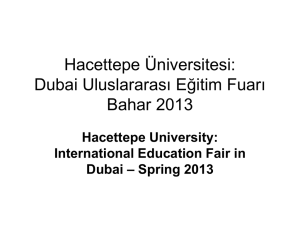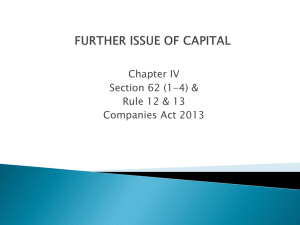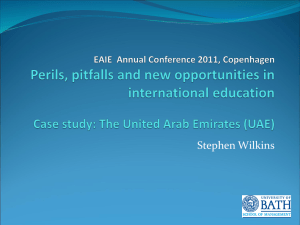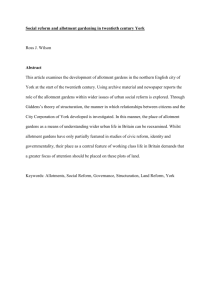PPT_DUBLIN_GG_9-10-2013_oe - COST
advertisement
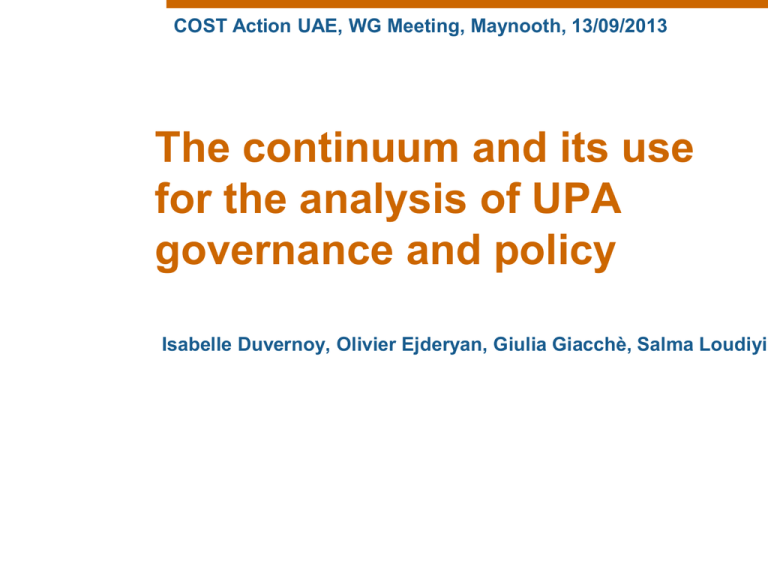
COST Action UAE, WG Meeting, Maynooth, 13/09/2013 The continuum and its use for the analysis of UPA governance and policy Isabelle Duvernoy, Olivier Ejderyan, Giulia Giacchè, Salma Loudiyi COST UAE, WG2 From governance to policy analysis Variety of forms of UPA along the continuum • Giulia Giacchè; Various modes of governance (of UPA) Salma Loudiyi, Isabelle Duvernoy; Public Policies • Olivier Ejderyan 2 COST UAE, WG2 continuum The “continuum” concept was proposed also by several authors in order to define: sociology attempting to understand the social changes consequent upon rapid urbanization (Redfield, 1941), space (Pahl, 1968; Bryant, 1982; Cecchi, 1988; Saraceno, 1994; Champion & Hugo, 2004; Gant et al., 2011, Schlesinger, 2013), design strategy (Viljoen and Bohn, 2005), the typologies of landholders’ (from lifestylers to farmers) (Maller et al, 2007) or actors (Overbeek, 2009), the implication in politics and urban planning (Small, 2006; Mason and Docking, 2005), 3 COST UAE, WG2 WG2 Continuum Our proposal of the “continuum” is based on actors -from “urbanites involved in UA” to “professional farmers” (Ejderyan and Cavin, 2012), space (from the city center to the countryside) and the relation established between them (10 forms of UPA). central Urban boundairies Farmers peripheral 4 COST UAE, WG2 WG2 Continuum 2 problem to solve: How to interpret the continuum ? How to interpret the forms of UPA? Some proposals for continuum: Allotment Garden (Raval District) Urban Allotment garden for retired people living in the surrounding of Can Masdeu Allotment Garden on Galecs Park 5 Exemple of Barcelona based on actors and space central boundairies Farmers peripheral COST UAE, WG2 WG2 Continuum Exemple of Espace de Gallecs of Barcelona based on “form” and its characterisation 6 COST UAE, WG2 Definition Form of UPA interpretation Are we sure that we are talking about the same thing when we’re talking about allotment gardens in different country? kleingärten (Austria, Swiss and Germany); allotment gardens (England) Unido, ogródek dzialkowy (Poland), rodinná zahrádka (Czech Republic), kiskertek (Hungary), volkstuin (Netherlands), jardins ouvriers or jardins familiaux (France and Belgium), kolonihave (Denmark), kolonihage (Norway), kolonitraedgard (Sweden), siirtolapuutarhat (Finland), shiminnoen (Japan). 7 COST UAE, WG2 Definition Are we sure that we are talking about the same thing when we’re talking about allotment gardens in different country? kleingärten (Austria, Swiss and Germany); allotment gardens (England) Unido, ogródek dzialkowy (Poland), rodinná zahrádka (Czech Republic), kiskertek (Hungary), volkstuin (Netherlands), jardins ouvriers or jardins familiaux (France and Belgium), kolonihave (Denmark), kolonihage (Norway), kolonitraedgard (Sweden), siirtolapuutarhat (Finland), shiminnoen (Japan). 8 COST UAE, WG2 England Allotment garden (England) An "allotment garden" is defined in the Allotments Act 1922 as an allotment not exceeding 40 poles (or 1,000 square metres) which is wholly or mainly cultivated by the occupier for the production of fruit or vegetables for consumption by himself and his family, and this definition is common to all the statutes in which the term occurs. An "allotment garden" is what people commonly mean by the term allotment, that is a plot let out to an individual within a larger allotment field. Local authorities' duties and powers now in general only extend to allotment gardens. "an allotment garden, or any parcel of land not more than five acres in extent cultivated or intended to be cultivated as a garden farm, or partly as a garden farm and partly as a farm.” (Allotments Act 1925) The Law of Allotment (1922) is discussed on : Mitchell (1922), THE LAW OF ALLOTMENTS AND ALLOTMENT GARDENS, P. S. KING & SON, LTD. 9 COST UAE, WG2 STATAL LEVEL _ Rural developement France Jardins familiaux (France) « Les associations de jardins ouvriers, qui ont pour but de rechercher, aménager et répartir des terrains pour mettre à la disposition du chef de famille, comme tel, en dehors de toute autre considération, les parcelles de terre que leurs exploitants cultivent personnellement, en vue de subvenir aux besoins de leur foyer, à l'exclusion de tout usage commercial, doivent se constituer sous la forme d'associations déclarées ou reconnues d'utilité publique conformément à la loi du 1er juillet 1901.» (art. 561-1 of Rural Code). “Les associations ou sociétés qui ont pour but de grouper les exploitants de jardins familiaux pour faciliter l'exploitation de ceux-ci et de favoriser par une propagande éducative le développement des jardins familiaux doivent se constituer sous la forme d'association déclarée, conformément à la loi du 1er juillet 1901.” (art. 561-2 of Rural Code). 10 COST UAE, WG2 Island MUNICIPALITY LEVEL / Planning sector Allotment gardens will be established in all ten neighborhoods (Draft for UA policy to be part of the next Municipal plan of Reykjavik, Oct.2012) With regard to the implementation of the policy, following steps are suggested: Allotment gardens: • In each neighborhood there will be facilities for the common vegetable gardens and/or allotments. Location of the gardens will be determined in neighborhood and site plans. • The city will initiate cooperation with the local energy company for use of (surplus/waste) warm water to warm up soil to improve conditions for vegetable growing. • The city will initiate cooperation with the local waste management company to set up recycling centers for organic waste for composting in connection with the allotment gardens in all neighborhoods. 11 COST UAE, WG2 Ireland STATAL LEVEL : Specific policy The Allotment Act (1926) identified an allotment as a “means a piece of land containing not more than one-quarter of a statute acre let or intended to be let for cultivation by an individual for the production of vegetables mainly for consumption by himself and his family”. Planning sector Allotments are defined as “an area of land comprising not more than 1,000 square metres let or available for letting to and cultivation by one or more than one person who is a member of the local community and lives adjacent or near to the allotment, for the purpose of the production of vegetables or fruit mainly for consumption by the person or a member of his or her family” (The planning and Development Act, 2010). The Act also allows local authorities to indicate in a Development Plan an intention to reserve land for use and cultivation as allotments, and for regulating, promoting, facilitating or controlling the provision of land for that use. 12 COST UAE, WG2 Ireland Departemental Level (ex. Fingal County) / Development plan Fingal County Development Plan Chapter 3 – Green Infrastructure, states: Objective GI27 “Provide opportunities for food production through allotments or community gardens in new green infrastructure proposals where appropriate.” Objective GB04 “Promote the provision of allotments within the rural areas of the County especially within the Greenbelt, which have good access from the built-up and residential areas.” -specific policy Fingal Allotment Strategy (march, 2012) In Fingal area there are 600 allotments provided by Fingal County Council and the provision of approximately 200 more allotments. A strategic approach is required to address the increasing demand and to ensure the benefits of allotment gardening are properly recognised and available to all. This strategy seeks to improve the quality and quantity of allotments and to provide support for the development of allotments by identifying ways to give more people the opportunity to grow their own food and promoting other food growing initiatives. Key Policies 1: Ensure sufficient provision of allotments / 2: Ensure good administration/ Provide high quality allotments / Ensure environmentally sustainable allotments / Secure resources 13 COST UAE, WG2 MUNICIPALITY LEVEL (ex. Dublin) / Economic sector Dublin city development plan (2012-2017)_ Chapter 6 “Greening the city” It is the policy of Dublin City Council: To support the provision of community gardens/allotments/ local markets/pocket parks, where feasible and in particular as temporary uses on vacant, under-utilised or derelict sites in the city It is an objective of Dublin City Council: To support on a phased basis, the development of allotments on appropriate sites in the city 14 WG2: Governance and local public policies for urban agriculture Reflections from Isabelle Duvernoy, Toulouse, UMR Agir Salma Loudiyi, Clermont-Ferrand, UMR Metafort COST UAE, WG2 Introduction We are inspired by: - French public system, where there is a strong sectorial organisation of farming (neo-corporatism) - Two kinds of litterature, classical litterature in political sciences (difference btw politics, policies, and polity) and the school of deliberative policy analysis (Hajer, Wagenaar…) Urban and periurban agriculture (U&PUA) depends on several kinds of public policies: sectorial farming policies (for instance, CAP 1st pilar), and transversal policies (i.e. land planning, water management), some of which can be locally designed (Leader). In some cases, places (town, aglomerations) provide economic support to U&PUA (Vandermeulen et al.). In other cases, they develop or implement policies helping to maintain Urban farming: land planning, land buying, marketing organization, buying products, education etc. Other actors, organised in networks, lobbies, favorize U&PUA… with new legitimacies to act. Which organisation of all this in a place? Governance for U&PUA. NB:16analytic and normative dimensions in the term of governance COST UAE, WG2 Dimensions of governance : An illustration Legitimacy (elected, expert, common experience) Institutional Political dimension Regulatory dimension State-Non State dimension Forms of democracy Informal-formal actors Hard – Soft Law Forms of public management Quantity and diversity of Quantity and diversity of Quantity and diversity Multi-scalar actors engaged in the actors with some degree of of actors engaged in Sectorial/transversal institutionalized process power or influence over the regulatory Local/general… common good/general interest in question decision /output arrangement Mono- polycentrical forms of decision and power Formal or informal forums for the decision making Originofand nature of Actual formal decisionPrecision (how closely Diversity actors involved in decision making mandate making power does the output Partnerships, public-private partnerships Nature and extend of Actual not formal ability to prescribe and Form consultation of regulation (soft or hard): prescription or incitation with affected influence decisions and constrain private etc… interests outcomes action?) Outcome: formal decision Obligation (how or “rolling” supervisory legally binding is the Numerous descriptions based on different dimensions, linked to different theories. power obligation?) SeveralMonitoring typologiesand of governance forms Delegation implementation From Tollefson et al., 2012, page 14 17 COST UAE, WG2 Patterns Centralized Sectorial Governance Neo-corp Neo-liberal Sectorial Hierarchy and Scale General decision making General interest Etatist Negociated, balanced Diversity of actors and interests Transversal (interdependance) Collaborative synergies Local structuration of the sector « territorial » Place-based governance (and Partnerships) Local decision making Locally defined common good 18 COST UAE, WG2 So what? The governance notion - Governance structures but also processes (it’s dynamic) - Broaden a lot the issue (forms of government, of public action, powers, legitimacies of private actors in public domains, forms of linking scales etc.) - Sharpen the discussion: from the diversity of public policies to the organization of their common implementation, of the actors involved, of their form of involvement A normative notion - Should we advocate for one form of governance? Based on which analysis? (Defending which values? With which legitimacy to do so?) - How to compare between countries with distinct institutional cultures? Proposal - Describing the effect of the governance on the diversity of U and PUA forms (cf the “continuum”) * the diversity taken into account and supported by public policies (cf. Carlos’ grid) * the diversity of actors (power? legitimacy?) representing agriculture in the governance processes - Developing tools to improve discussions and co-ordinations btw different actors (cf. Toulouse TS) 19 Approaching public policy But where from? Olivier Ejderyan, Geography Unit, University of Fribourg COST UAE, WG2 UPA policies in the reference regions 21 Dublin: “There is no national policy on UA. The prerogrative is retained by local governments” Geneva: “There are no laws, policies or guidelines taht are specifically mentioning UA at any institutional level” Milano: “The public policies that support UA are mainly linked to other themes” COST UAE, WG2 UPA in policy “All participants report that there is policy development and innovation at municipal level around UA, though frequently this may be only indirectly aimed at UA” (WG2 02/2012 scoping doc) “Few mentions of UPA policies beyond the municipal level”; what does this mean? Need for clarification on the used terminology 22 COST UAE, WG2 What is a (public) policy for UPA? Public policy: “A course of action or inaction chosen by public authorities to address a given problem or interrelated set of problems” (Pal, 2010); Example: ^ Legal framework for allotment gardens are to be found in all Europe; ^ Are they necessarily part of a UPA policy everywhere? ^ Ex.: Genève. http://etat.geneve.ch/dt/amenagement/projet-7235301-13395.html ^ Ex.: Fribourg. http://www.villefribourg.ch/vfr/fr/pub/officielle/affaires_bourgeoisiales/propriete_instit /jardins_fam.htm 23 COST UAE, WG2 Continuum and policy Allows to take stock of forms of UPA Which actors, which policy sectors are involved in specific forms of UPA The continuum Forms of UPA Support or conflict with existing forms of UPA 24 Must UPA be named, and by whom? The Carlos table Governance of UPA Structures modes of governance Which formalised policies influence UPA Policies relevant for UPA COST UAE, WG2 A basis to fill the Carlos model 25 COST UAE, WG2 Why start from the forms & modes of governance Relevant scale is provided by the actors involved in the issues; Might inform about «chosen inaction» as policy options; Might reveal relevant policy sectors or subsectors we did not think of. 26 COST UAE, WG2 So what ? Our analysis of public policies must address strategies chosen by public authorities (≠ governance, but builds on governance); We cannot examine «exisiting policy cycles» on UPA; We must reconstruct UPA policies transectorally. 27 COST UAE, WG2 What type of analysis can/should we provide? 28 Policy analysis: “an applied social science discipline which uses multiple methods of inquiry and arguments to produce and transform policy-relevant information that may be utilized in political settings to resolve policy problems” (Peter deLeon and Danielle M. Vogenbeck, in Fischer et al., 2007). COST UAE, WG2 Bonner K., (1998), Reflexivity, sociology and the rural–urban distinction, in Marx, Tonnies and Weber, Canadian Review of Sociology, 35, 165–189. Bryant C.R., Russwurm L.H., McLellan A.G., (1982), The city’s countryside – land and its management in the rural– urban fringe, London: Longman. Cecchi C., (1988), Distretto industriale: l’agricoltura dalla complementarietà alla dissociazione, in La Questione Agraria, 32. Iaquinta D. L., Drescher A., W., (2000), Defining Periurban: Understanding Rural-Urban Linkages and Their Connection to Institutional Contexts, presented at the Tenth World Congress, IRSA, Rio, August 2000. Maller C., Kancans R., Carr A., (2007), Biosecurity and Small Landholders in Peri-urban Australia, © Commonwealth of Australia Redfield R., (1941), The Folk Culture of Yucatan. Chicago, University of Chicago Press. Kdagreen, (2003), A description of the Folk Urban Continuum as depicted by Redfield and Chan Kom: A Maya Village, in WriteWork.com URL: consulted 26 august 2013) http://www.writework.com/essay/description-folk-urban-continuum-depicted-redfield-and-cha NPTEL, Humanities and Social Sciences, Introduction to Sociology, Module 3 Social Structure and Social Change Orsini S., (2013), Landscape polarisation, hobby farmers and a valuable hill in Tuscany: understanding landscape dynamics in a peri-urban context, in Danish Journal of Geography, 2013 Vol. 113, No. 1, 53–64 Overbeek G., (2009), Opportunities for rural–urban relationships to enhance the rural landscape, in Journal of Environmental Policy and Planning, 11, 61–68. Pahl, R.E., (1968), The rural–urban continuum, in R.E. Pahl (Eds.), Readings in urban sociology, pp. 263–297, London: Pergamon Press Saraceno E., (1994), Alternative reading of spatial differentiation: the rural versus the local economy approach in Italy, in European Review of Agricultural Economics, Vol. 21, n 3-4. Schlesinger J., (2013), Agriculture along the urban-rural continuum. A GIS-based analysis of spatio-temporal dynamics in two medium-sized African cities, PhD Thesis, Faculty of Environment and Natural Resources, AlbertLudwigs-Universität Freiburg im Breisgau, Germany Small R., (2006), The Siyazama Community Allotment Garden Association, Cape Town, South Africa. Tomkins M., (2006), The Edible Urban Landscape. An Assessment Method for retro-fitting urban agriculture into an inner London Test Site, MSc Architecture: Advanced Environment and Energy Studies, University of East London. Viljoen, A., Bohn K., Howe J., (éds), (2005), CPULS: Continuous Productive Urban Landscapes, Designing Urban Agriculture For Sustainable Cities, London, Elsevier 29 WG2 Report of Germany, Iceland, Ireland, COST UAE, WG2 We were inspired by the reading of: Ars B., van Tatenhove J., 2004. Policy and power: A conceptual framework between the ‘old’ and ‘new’ policy idoms. Policy Sciences, 37, 339-356. Connelly S., Richardson T., Miles T., 2006. Situated legitimacy: Deliberative arenas and the new rural governance. Journal of Rural Studies, Volume 22, Issue 3, 267-277. Dumas B., Séguier M., 2004. Construire des actions collectives. Développer des solidarités. Editions de la Chronique Sociale, Lyon, 3ème édition, 226 p. Hajer M.A., Wagenaar H., 2004. Deliberative policy analysis. Understanding governance in the network society. Cambridge University Press, 307p. Innes J.E., Booher D.E., 2004. Collaborative policymaking: governance throuch dialogue. In: Hajer and Wagenaar… Létourneau A., 2009. Les théories de la gouvernance. Pluralité de discours et enjeux éthiques. VertigO - la revue électronique en sciences de l'environnement [En ligne], Hors série 6 | novembre 2009, mis en ligne le 09 novembre 2009, consulté le 22 juillet 2013. URL : http://vertigo.revues.org/8891 ; DOI : 10.4000/vertigo.8891 Mathur N., Skelcher C., Smith M., 2003. Towards a discursive evaluation of partnership governance. Paper to European Consortium for Political Research joint sessions, Edinburgh, march 2003 -School of Public Policy, University of Birmingham, 49 p. Tollefson et al. Symposium overview: conceptualizing new governance arrangements. Public administration, Vol. 90, No. 1, 2012 (3-18). Trouvé A., Berriet-Solliec M., Déprés C., 2007. Charting and theorising the territorialisation of agricultural 30 Journal of Rural Studies, 23 , 443–452 policy.

